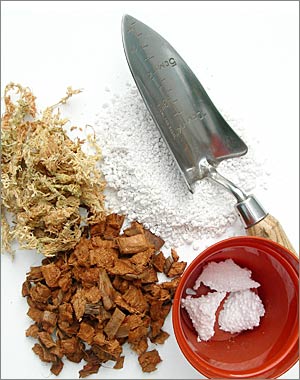
When to Repot
Repotting should ideally be performed in the early spring. If it is done in the autumn it may stunt the maturation of the new shoots and pseudobulbs and prevent flower spike development.
Like many plants, orchids should only be repotted when necessary such as when the pot is packed to capacity with growth or if the growing media has broken down. Usually re-potting is performed every third year and the growth anticipated in that time should dictate the size of pot to be used next. The orchid should be repotted with the newest pseudobulb furthest away from the pot rim to allow advanced growth in the coming years.
It is very important to appreciate that repotting time is an opportunity to examine the plants health and may also a time to propagate by splitting apart those plants having multiple growths. Some orchid genera are notoriously resentful of being divided up these include Coelogynes which like to grow unabated into large clumps.
Epiphytes
Epiphytic orchids being those which in their native habitat dwell on a loose substrate of leaves and old wood strips will obviously require a free draining media in cultivation. Sterilised Douglas Fir pine bark chips have been favoured for many years. However fungal contamination of these trees has become a threat to forestry and consequently this has restricted its availability.
Recently coconut (or coir) chippings have become a worthy alternative. Coir is cheaper, takes longer to degrade and is more hygienic than fir bark. Coir is more sponge-like and is also more water-retentive than fir bark and so plants grown in it require less frequent watering. Note, you must never plant your orchids in the grade of wood or coir chippings sold for garden mulching. The best source of orchid substrate is your orchid society particularly as many of the propriety brands sold in garden centres are of poor quality. You may also purchase bark on eBay (though postage costs may be expensive) or conveniently in Ireland obtain it at the Spring Orchid Fair at Glasnevin. Regardless of which type of bark you use it should always be bought fresh and then mixed with perlite which is a marvellous water absorbing volcanic rock pellet available from most garden centres.
Some orchids grow best in moss and perlite mixes without bark or a reduced bark content, for example the Pleione, Neofinetia and Stanhopea genera.
New Zealand sphagnum moss is now popularly used and is supplied as dehydrated bales. It is sterilised so you won’t be introducing foreign beasties into our ecosystem and it is farmed from sustainable areas so it is a very green product. The disadvantage of moss is that it degenerates more rapidly than bark and has to be replaced at least every other year.
Some orchid species resent being potted and any type of substrate stifles their growth. These are best grown on cork slabs or similar mountings and frequently misted and are better suited to the humid atmosphere of a greenhouse. An example are species from the genus Barkeria.
Never mix growing media from one orchid to another and always sterilise cutting implements over a flame or by bleach immersion. This may seem tedious but it is good practice.
Lithophytes
Some foreign orchids grow on sun-baked rock surfaces and these are termed lithophyic or rupicolous. They can be intolerant of the growing composts discussed preferring a stone based medium. Examples of these include the Mexican lithophytic Laelias, which although very beautiful are high maintenance and so not commonly found in collections. They are not to be confused with the Mexican epiphytic Laelias which are much easier to cultivate.
Terrestrials
Finally, as well as epiphytic and lithophytic growers there are those which grow in the ground like “normal” plants and these are termed terrestrials. They have roots somewhat like “normal” plants and so do not generally succeed in the coarse growing media previously described. Terrestrials predominate in the temperate regions of the world including Ireland. Unlike their evergreen tropical cousins which do not have dark winters to endure, terrestrial orchids are deciduous and have evolved underground tubers or rhizomes to sustain them through the winter. The epiphytic lifestyle would be a failure in temperate climates because there is insufficient atmospheric humidity or regular daily rainfall. As with all orchids the key to growing terrestrial orchids successfully is good drainage.
Typical growing media used include mixes of perlite, coarse sand, gravel, fine bark, leaf mould, and charcoal and sometimes a tincture of garden lime to increase pH if required.
It is recommended you consult a specialist grower or manual to discover the relative amounts to use for your orchid of interest. For example some Cypripediums will only survive if growing solely in coarse sand and are intolerant of organic matter. Terrestrials can be grown in pots but care must be taken to ensure they get the correct moisture and never dry out.
Did you know...
The miniature orchid Neofinetia falcata was revered by Japanese Emperors and Samurai. It was prohibited for anyone else to own one. Commoners were permitted viewings but only if they wore paper masks to prevent them breathing on the plants!
